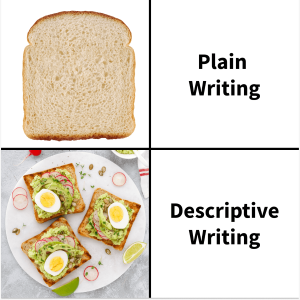
Descriptive writing makes your text more immersive. It helps your readers to paint a vivid picture in their heads.

Plain writing: The flowers were pretty.
Descriptive writing: The colorful flowers brought life to an otherwise lifeless sidewalk. The different shades of the green stems and leaves were the perfect backdrops to the yellow, orange, and red petals that seemed to sway softly with the breeze.
Imagine this: It’s lunchtime, and you’re hungry. You sit down to eat at a restaurant and are surprised to see there are only two options on the menu. One is a single piece of room-temperature bread. The other is toasted bread with avocado, onions, peppers, scallions, and a fried egg on top of it. Which option are you going for?
Think of the room-temperature bread as writing that lacks descriptive details. The avocado toast? That’s descriptive writing that leaves your readers satisfied. Intrigued? Continue reading below to learn more about what descriptive writing is, why it’s important, and how to include it in your writing.

So, what exactly is descriptive writing? It’s when you immerse the reader into your writing, whether you’re describing people, places, objects, or scenes. Descriptive writing allows the reader to paint a picture in their head. Descriptive writing makes your text more appealing and therefore draws in the reader.
But which type of writing benefits from descriptive writing? Nearly all of them do; especially creative writing. You’ll want to steer clear of descriptive writing in technical papers or academic writing. Unless, of course, your academic paper is about literature or writing. Professional emails also shouldn’t include descriptive writing. For example, if you’re sending an email to your boss explaining that you’re home sick, the last thing you want to do is add details.
There are many writing hacks you could use that’ll improve your text. Using descriptive writing can help enhance your text for many reasons:
There are several ways to use descriptive writing in your text. We’ll cover a few of them below and provide examples.
Adding specific details helps your readers visualize what you’re writing about.
The bakery smelled good.
↓
As soon as I walked into the bakery, I was greeted by the warm, intoxicating air of freshly baked cookies.
Some words are more accurate than others and can help you better portray what you’re writing about.
She wore a red dress.
↓
She wore a scarlet-colored dress.
Figures of speech can make your writing more relatable and easier to understand.
I was excited.
↓
I felt like a young boy on Christmas morning getting ready to open all his presents.
Descriptive writing can make your writing magical. It can transport your readers from their sofas to whatever it is you’re writing about. But as powerful as descriptive writing can be, it cannot undo the negatives brought upon by spelling and grammar errors. That’s why it’s always a good idea to use LanguageTool as your writing assistant. Not only will this multilingual text editor detect and correct errors, but it will also provide the synonyms you need that’ll help make your writing more descriptive.
Share on Social Media
Gina holds a Bachelor of Arts in English. With a passion for creating art with words, she spends her free time reading and writing. And no, we didn’t force her to say that. You can find her strolling the shorelines with her loyal canine companion, Mango, or (painfully) cheering on her favorite team, the Miami Dolphins.
Go well beyond grammar and spell checking. Impress with clear, precise, and stylistically flawless writing instead.
We’ve made a mistake, forgotten about an important detail, or haven’t managed to get the point across? Let’s help each other to perfect our writing.

Hardworking (also spelled hard-working) is an adjective that describes someone or something as “constantly putting engaged and strenuous effort into a job or task.” The word “hardworking” is commonly used in resumes to convey that an individual is ambitious and resolute, making them an ideal candidate to hire. Example: Using

Thank you in advance is a phrase many people use in their business emails, typically after they’ve made a request. A variant of this phrase is thanks in advance, but both are used in similar contexts. Example: Thank you in advance Dear Lauren, I will be out of the

“Going forward” is a popular business phrase that is commonly used to refer to future actions or strategies. It is frequently used to imply a change or progression from the current state. Example: Going forward in an email Dear Jessica, Thanks for coming into the office—the presentation was a